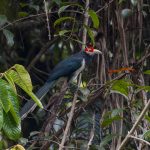
Comb crested Jacana
Happy New Year
Since the new year the rain has been very generous on the Sunshine Coast such that birding has been undesirable. And so it was the fourth of January when the weather allowed, even encouraged a brief trip into the field.
With all of the rain it was perhaps an obvious choice to visit some local wetlands. My main aim was to make a belated start on my year’s list. I have started a competition for the birders and bird photographers in my local Sunshine Coast area to encourage people to get out birding and also to develop their birding skills; especially identification.
So the fourth allowed me to get a few images of a few common species – low hanging fruit in the words of some.
The first stop was Parklakes; an urban area around an artificial wetland. It is near the town of Bli Bli, just one of the many towns sporting an indigenous name. In this case ‘Bilai’ was the word for a local tree, the casuarina. Bilai Bilai means many casuarina trees. Bilai Bilai morphed into Bli Bli.

From the main hide there were a few species easily seen; Little Black and Little Pied Cormorants, Pacific Black Ducks [middle above] and Wandering Whistling Ducks [left and right of the Pacific Black], Dusky Moorhen and Australian Swamphen plus the delightful Comb crested Jacana.

Little Egrets [below] were hunting close by and there was a sole Intermediate Egret at the other end of the swamp. The rain had filled these wetlands causing wetland species to spread out and there were a few species conspicuous by their absence. The lack of edge on the ponds meant no migratory waders, which was disappointing. Brown, Lewins, White cheeked and Scarlet Honeyeaters were calling as was a Little Wattlebird and a Restless Flycatcher. A Sacred Kingfisher flew through but, all in all, it was a little quiet.


Stop number 2 was the Maroochy Sewerage Ponds. A site with poor access but occasionally interesting birds. Today viewing from the road was a small flock of about 30 White winged Terns [below], a summer visitor to these parts. Keeping them company was a large group of Silver Gull – the only gull generally recorded. Pied Stilt, Black fronted Plover [Dotteral] were also in attendance as were a few Chestnut Teal. Mistletoebirds, a type of Flowerpecker, were vocal.





Last site before the midday heat ended proceedings was the Wappa Dam where Great crested Grebe were easy to see.
Not too bad a morning and the first 25 species photographed.













Leave a Comment